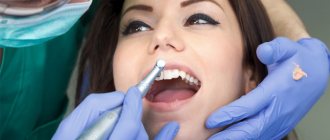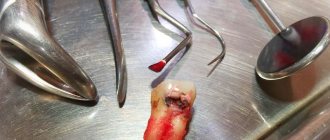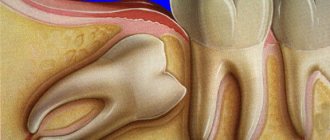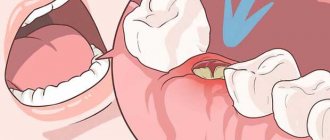Mechanical damage to a tooth due to injury without violating its integrity is called a bruise. This type of injury is common in children and adults, especially athletes. According to statistics, among all injuries to primary teeth, bruises account for 2.5%; bruises of permanent teeth account for 1.5% of the total number of traumatic injuries in the permanent dentition.
Even if the tooth looks unchanged after a bruise, it is necessary to visit a dentist to prevent the development of complications associated with the injury.
What it is
One of the most common dental injuries, mostly occurring in childhood, is bruising. Of course, this kind of damage cannot be ruled out in adults, especially those leading an active lifestyle and involved in traumatic sports.
A tooth bruise is a closed injury caused by strong mechanical impact with a hard object. In this case, the integrity of the bone tissue and the anatomical position are not damaged, but the periodontal tissues suffer, sometimes severe rupture occurs, followed by bleeding.
If the blow was so powerful that the neurovascular bundle was damaged, the tooth may become stained or darkened due to hemorrhage into the dentinal tubules and pulp tissue. Occasionally, with a bruise, numbness is one of the accompanying signs, as well as external damage to the facial area in the injured area, as well as the appearance of swelling and bruising. In any case, most often all these damages are reversible and can be treated if you consult a dentist in a timely manner.
What to do if your teeth are loose and your gums hurt
When gums bleed and become inflamed, teeth can also become loose and even fall out. One of the factors that provokes this condition is acute or chronic gingivitis. The inflammatory process provokes a light plaque on the teeth consisting of microbial pathogens or the formation of tartar on the teeth if you do not take good care of the oral cavity. If gingivitis is not treated, the germs travel deeper into the tissue. Periodontitis develops when pus forms on the gums, the necks of the teeth are exposed, and constant pain appears.
With periodontitis, the inflammatory process occurs in the tissues, from the base of the tooth root. At the same time, gumboil appears and the gums become very swollen and painful. Sometimes, due to chronic infection, cysts form on the gums; they do not appear immediately. In severe cases, a granuloma forms on the gums, in which bacteria attack the gums and roots of the teeth. In this case, the person experiences severe itching and high fever.
Also, gums can hurt after tooth extraction, installation of implants, braces, appliances, or improper dental treatment.
If your teeth are loose in your gums, you should not:
- Press your finger on the gum
- Heat with compresses, sand, warm rinses
- Open an abscess at home
- Taking too many painkillers
First of all, you need to relieve pain with pills or injections. But under no circumstances should you exceed the dosage. Paracetamol, analgin, ketanol and other similar products are suitable. You can also use gels with an analgesic and cooling effect.
You can rinse your mouth with Chlorhexidine and Miramistin. This needs to be done in the morning at lunch and in the evening to get results.
Causes
Like any other injury, a tooth bruise can have a wide variety of causes. This could be an accidental hit in the jaw with a ball or other sports equipment, an unfortunate fall, a strong blow in a fight, or the consequence of a road accident or riding a bicycle. All these reasons have one thing in common - a strong blow of a mechanical nature.
Children and athletes are the most vulnerable to such injuries. It is these two categories of patients with a similar diagnosis that are the most frequent visitors to dental clinics. However, household injuries, as a result of which a person accidentally or recklessly hits a tooth, can cause a bruise. In this case, the most unprotected and weakest anterior and lateral incisors on the upper jaw most often suffer due to the anatomical structure and overhang of the upper jaw over the lower jaw.
Diagnosis of pathology in the dental office
If your tooth hurts or becomes numb after an impact, or if it has moved, you should immediately consult a dentist. The specialist will conduct an external examination and palpation. The doctor will also definitely send you for an X-ray examination to determine the condition of the tissues and their integrity, detect internal damage, and differentiate the bruise from other possible injuries (fracture, dislocation, crack). In order to check the condition of the pulp, to identify traumatic pulpitis and periodontitis, electroodontic diagnostics (EDD) can be performed.
Symptoms
The symptoms accompanying a tooth bruise are easy to recognize. If a person bruises a tooth, it hurts quite noticeably, and over time the pain only intensifies, especially with pressure on the damaged area and chewing food. The following symptoms are also present:
- When the neurovascular connection is ruptured, hemorrhage occurs into the pulp tissue, due to which the enamel quickly turns pink;
- The crown may darken;
- When bruised, the tooth becomes loose, although its mobility is relatively small;
- At the site of impact on the soft tissues of the gums, swelling, hyperemia, deformation of individual areas of the mucous membrane, and the formation of hematomas may occur;
- If there is a very strong impact, ligament rupture, joint damage, or even a fracture of the alveolar process of the jaw may occur where the striking object hits the jaw. In this case, it will be difficult and painful for the patient to open and close the jaw. Such damage can only be diagnosed with an x-ray.
Diagnosis and treatment of tooth fracture
A coronal fracture is diagnosed during an examination by a dentist. To confirm or exclude a root fracture, targeted radiography is prescribed. Electroodontometry may be indicated to assess the condition of the pulp.
Treatment of a fracture of the coronal part is a complete restoration of the tooth crown using composite materials, a permanent crown and a stump inlay. In case of complications, treatment of pulpitis is carried out with further restoration of the tooth.
For tooth root fractures, treatment options may include:
- endodontic root treatment;
- tooth extraction followed by replacement.
Consequences
Not a single injury for a person passes without a trace. Even if you managed to avoid obvious complications at the time of treatment, there is always a possibility of their occurrence in the future. For a tooth bruise, the consequences are also no exception. One of the most common complications is the gradual death of pulp tissue if the pulp was damaged by an impact, but during treatment, identifying its viability gave positive results. With necrosis, the nerve endings in the tooth cavity are damaged, which inevitably leads to inflammation.
Another most common consequence of a bruise is staining of the enamel. Most often, it occurs in a short time after injury, since fluid from damaged vessels enters the dentinal tubules and stains the walls. In addition, the enamel may simply darken due to a lack of nutrients supplied through damaged fibers and tissues.
More serious complications that arise over time are also possible. This may be the development of a cyst, periodontitis, or a stop in root development in children in both milk and permanent teeth.
The likelihood of tooth loss after injury: what doctors say
Can a tooth fall out after a blow? This situation is rare, but it cannot be excluded if the supporting ligaments and periodontal tissues are severely damaged, and the person does not seek dental care for a long time.
More often, after a blow, the tooth hurts and only wobbles a little, and the gums around it are red and swollen. But even in this case, you cannot relax. According to doctors, against this background traumatic gingivitis and periodontitis can develop. These diseases, with inadequate treatment and careless attitude to oral hygiene, progress and become generalized (spread to the entire range). Advanced periodontitis is also fraught with loosening and loss of moving elements.
Diagnostics
What action should you take if you or your child gets a tooth bruise? First of all, you need to contact a dental clinic as soon as possible. Using an X-ray, as well as after palpation and a thorough visual examination, the doctor will determine the extent of the damage resulting from the bruise, and will also draw up a detailed plan for further treatment.
When a tooth is bruised, diagnosis must certainly include, in addition to identifying obvious symptoms, an x-ray examination to exclude possible internal injuries, such as a fracture of the root or alveolar process. In addition, damage to the periodontal area, if present, will be visible in the image.
Also, over the course of several days, the doctor must monitor the condition of the pulp using electroodontodiagnosis. It helps to identify even the initial stages of necrosis and remove damaged tissues in time before they begin to become inflamed.
What indicates pathology: characteristic signs
A bruise is an insidious pathology, since immediately after it you may not notice any external manifestations of the injury at all. However, doctors warn that when a blow or bruise occurs, a negative effect on periodontal tissue occurs, their rupture and internal bleeding may occur, and in some cases, the neurovascular bundle, that is, the pulp, is also partially or completely damaged.
How can you independently determine whether you have a problem? We list the main symptoms that should alert you and become a reason for mandatory consultation with a doctor.
- Teeth hurt after being hit. The unpleasant sensations are long-term, aching in nature, intensified by biting and pressing on the crown while chewing food, or by tapping on injured tissues. Acute pain may occur from eating hard, cold and hot, as well as sour and sweet foods.
- After the impact, my teeth became loose. Usually there is slight mobility of the damaged element of the row. It seems to a person that the incisor or fang is swaying and has begun to move to the side.
- The coronal part of the bruised unit has changed its color. Pink color indicates rupture of pulp vessels and internal hemorrhage. If a tooth turns black after an impact, this may indicate a violation of its nutrition and an inflammatory process occurring in the depths of the tissues. If it turns gray, then the symptom signals necrotization and death of the nerve.
Important! As a result of the bruise, partial or complete rupture of the pulp may occur. In the first case, the process is considered reversible, while in the second it is irreversible and requires invasive treatment methods. Only a doctor can find out what problem a particular patient is facing.
- Not only the tooth aches, but also the gums surrounding it. In this case, the bruised soft tissues and mucous membranes swell and turn red. A hematoma may appear.
- Some patients notice numbness in their teeth after an impact, which indicates severe damage to the nerve endings.
“Even if there are no external manifestations of injury, you should still consult a doctor who will conduct a thorough examination. Only on the basis of x-rays can we say for sure whether the patient will require treatment. If you hesitate, you can completely lose a tooth, even one that looks completely healthy,” says dentist-therapist Marina Igorevna Tarabanovskaya.
Treatment
In some cases, if the impact is not very strong, no treatment other than monitoring the condition of the damaged area is required. It is necessary to provide the affected tooth with long-term rest, apply cold compresses to reduce the bruise and relieve swelling. Solid food is completely excluded from the patient's diet for several days. Among other things, the doctor must observe the injured tooth for two to three months to avoid complications.
In children with baby teeth, it is possible to grind off the enamel on the cutting edge to remove the load from the damaged area; this action is not carried out on permanent teeth.
To eliminate the consequences resulting from a severe bruise, treatment should consist of a number of procedures:
- first of all, the damaged area is numbed with an anesthetic;
- if there is damage to the pulp sac, the doctor performs trephination, depulpation and thorough treatment of the dental cavity with disinfectants, after which the canals are sealed;
- if the neurovascular bundle has been damaged and the enamel has darkened or become stained, it is recommended to bleach permanent teeth using hydroperite, which will return the enamel to a more or less natural color;
- if necessary, the doctor can prescribe, in addition to complete rest, anti-inflammatory drugs and physiotherapy to help quickly eliminate the consequences of the injury.
Even if there is no severe pain after a blow to the jaw, it is recommended to visit a dentist to identify possible hidden injuries. This will help you maintain the health of your teeth for many years to come.
Diagnosis and treatment of tooth dislocation
Using an x-ray and available clinical data, the type of injury received is revealed. In addition, it is possible to conduct a radiovisiographic study to study the condition of the alveolar bone and the position of the tooth. Treatment is prescribed according to the specific type of injury.
In case of incomplete dislocation, therapy is indicated to preserve the tooth. It is repositioned with fixation using mouthguards, wire splinting structures or splints. It is also recommended to take medications to prevent infection and the development of the inflammatory process. A repeat examination by a dentist is carried out a month later.
Endodontic treatment is indicated in case of pulp death.
In case of complete dislocation, prosthetics are necessary. Sometimes replantation is performed: the damaged tooth is returned to the socket, splints or splinting structures are used for healing.
Treatment of impacted dislocations involves several options:
- tooth extraction and its replacement with a prosthesis;
- tooth extraction with its replantation;
- immediate reposition of the tooth with its subsequent immobilization;
- long-term reduction.
Complications after injury
Usually bruises do not affect the health of the teeth in any way, but sometimes they lead to complications. Among the most common are a strong change in the color of the enamel against the background of hemorrhage that appears in the pulp chamber. Over time, a damaged tooth may become gray or brown, this is due to a slowdown in metabolic processes occurring in the tissues.
If the pulp dies, a disease such as pulpitis may develop. If you ignore the first symptoms, the risk of developing periodontitis becomes very high. As a result, a post-traumatic odontogenic cyst may appear, which is localized on the upper part of the tooth root.
If a child whose molars have already emerged is injured, the development of the roots of permanent units may be disrupted. If the injury is in a very young patient, it can cause a disruption in the formation of the rudiments of future permanent teeth. In the absence of timely intervention, they may die.









